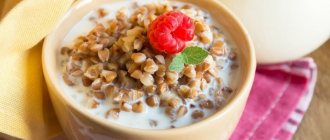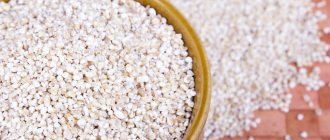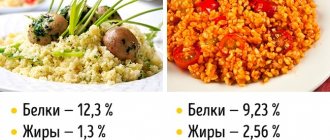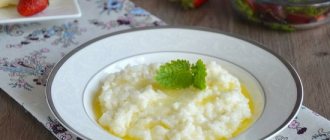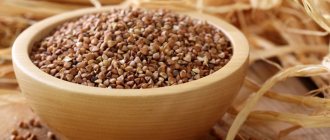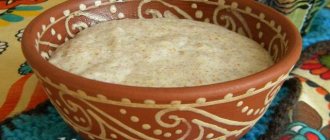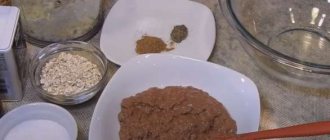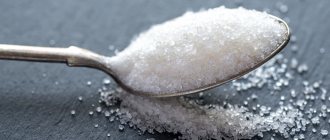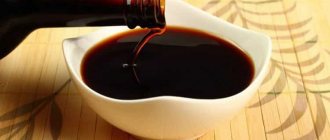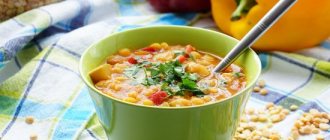Author: Kristina Lobanovskaya, doctor, practicing nutritionist Article updated: 11/09/2020
When following weight loss diets, performance and reaction speed often decrease. You can eliminate unpleasant symptoms by including cereals - natural sources of carbohydrates - in your diet. Millet porridge, whose calorie content is low, seems to be an excellent option. You can prepare it in different ways, in any case enriching the body with vitamins and getting a lasting feeling of satiety.
Dry
Millet is used to prepare millet porridge. It is made from millet, rich in microelements and vitamins. Dishes made from it turn out tender and tasty, and most importantly, they are quite easy to digest. It is noteworthy that this is one of the few cereals in which a record high amount of plant protein is determined, which is necessary to maintain strength and health in any diet.
For the first time, cereals, which are often called “golden”, were grown in China and Mongolia. Today it is widespread in many countries of the world and is successfully used in the cuisines of different nations. The grains of the cereal have a round shape and a specific smell, and are colored yellow. Also on store shelves you can find crushed cereals, which are cleaned in a special way and have a slightly flattened shape.
The calorie content of the dry product is quite high - 342 kcal per 100 grams, and the glycemic index is at an average level - 40 units. When cooked, the volume of millet increases and the calorie content decreases, so nutritionists recommend including the finished product in a limited diet. As for the health benefits of raw materials, it has been known for a long time. It seems especially valuable for people with heart pathologies. Since potassium is determined in the composition, in addition to benefits for the heart muscle, we can talk about normalizing blood pressure and removing excess fluid from the body. Millet cereal has an equally beneficial effect on the process of hematopoiesis and liver function. Experts note that it must be present on the table of people with diabetes, atherosclerosis and problematic pancreas.
To experience the effectiveness of millet in terms of health improvement and weight loss, you need to choose a quality product:
- The yellower the color of the grains, the tastier they are, so you need to choose a product in transparent packaging.
- The cereal should be matte. The presence of shine indicates the absence of polishing.
- The shelf life of the product cannot be long.
- The cereal should not have any foreign odor.
Important! A short shelf life - no more than 9 months - is one of the features of millet. This is due to the presence of fats in it, which undergo oxidation during storage. The longer millet cereal is stored, the more bitter its taste becomes.
First of all, millet cereals are used for preparing porridge, but are used with equal frequency in recipes for various baked goods, meat dishes and side dishes.
Calorie content
It is noteworthy that, having such a rich list of beneficial properties, millet porridge is a low-calorie and easily digestible dish. People who want to control their weight, adherents of a healthy diet, as well as athletes are probably familiar with the abbreviation KBZHU. In modern dietetics, special attention is paid to harmonious and balanced nutrition. K is the daily calorie intake, which is calculated individually for each person: it all depends on gender, age, and lifestyle.
But in order to lose or, conversely, gain weight, simply counting calories is not enough. Studies have confirmed that losing weight according to the principle of “we spend more calories than we consume” subsequently leads to the fact that the lost fat is replaced by flabby, sagging, unhealthy-colored skin, slow metabolism and multiple health problems. Therefore, the first place when drawing up an individual diet comes to the balance of BJU - proteins, fats, carbohydrates - components involved in the construction of muscle mass, cell regeneration, the functioning of the immune system, energy production, and so on.
As for the calorie content and nutritional value of millet milk porridge, the average values per 100 grams are as follows:
- calorie content – 93 kcal (with butter – 115 kcal, with sugar – 125 kcal, with fruit – up to 130 kcal);
- proteins – 4.3 g (with sugar), 3.4 g (with butter), 3.0 g (with fruit);
- fats – 2.5 g (with sugar), 5.2 g (with butter), 4.6 g (with fruit);
- carbohydrates – 21 g (with sugar), 14 g (with butter), 18 g (with fruit).
If desired, you can add berry jam, nuts, dried fruits, and pumpkin pieces to the porridge.
For people diagnosed with diabetes, the glycemic index of foods is of no small importance when planning a diet. This is an indicator of the effect of carbohydrates on changes in blood sugar levels. Diabetic patients are forced to follow a low-carbohydrate diet. Millet porridge helps reduce glucose levels; its glycemic index (GI) varies from 45 to 60 points, which is normal. It should be noted that the thicker the porridge, the higher its GI.
Due to its beneficial properties, millet also helps reduce blood cholesterol, improves digestion, normalizes blood pressure, and accelerates lipid metabolism, which makes it a favorite not only among diabetics, but also among adherents of proper nutrition.
On the water
Millet cereals cooked in water are considered viscous. It is characterized by a dim yellow color and a specific aroma of “golden” grains. When prepared correctly, the dish has a pleasant taste without bitterness. It is recommended to be included in diets for weight loss, in particular, the “6 cereals” diet. Slow carbohydrates contained in the finished product supply the body with energy that is consumed over a long period of time. The calorie content of millet porridge with water is 90 kcal per 100 grams, which is within acceptable limits. Despite the low calorie content, lean food satisfies well.
The benefits of a lean dish with water for those losing weight are obvious:
- cleansing the body of waste and toxins;
- removal of excess fluid;
- acceleration of metabolism;
- activation of the process of fat digestion;
- stabilization of carbohydrate metabolism;
- blocking the accumulation of subcutaneous fat;
- maintaining muscle volume.
Important! Millet porridge has lipotropic properties, that is, it prevents the deposition of fats under the skin and increases their consumption.
The best option for quick weight loss is lean millet porridge. We are talking about millet boiled in water without adding additional ingredients. It is not difficult to prepare: the cereal is washed, poured with water (600 ml per 200 g), brought to a boil and simmered over low heat for no more than a quarter of an hour.
To improve the taste of the finished product, you can use auxiliary components. The calorie content changes:
- with butter – 149 kcal per 100 g;
- with sugar – 73 kcal per 100 g;
- with butter and sugar – 154 kcal per 100 g.
Those who do not like viscous porridges are recommended to prepare crumbly ones. The difference is in the form of grains: to prepare crumbly millet porridge in water, raw materials of a darker color are used. The calorie content of the finished dish is 130 kcal per 100 grams. Before starting cooking, the grains are washed at least 5 times with hot water, and only then they are sent to the fire, brought to a boil and cooked until tender.
Cooled finished millet can be stored in the refrigerator for no more than 3 days.
Millet porridge for losing weight
A product such as millet porridge must be present in the diet of those who watch their figure. One of the main magical properties of this cereal is that it prevents the accumulation of fatty deposits.
In addition, its huge advantage is that it fills you up for a long time, despite its rather low calorie content. This effect is achieved due to the high fiber content and complex carbohydrates.
In addition, millet porridge is based on:
- vitamins of groups A, B, E and PP;
- copper;
- iron;
- proteins containing amino acids;
- manganese;
- silicon;
- fluorine.
The latter two in particular help strengthen teeth and hair follicles, while copper supports bones and muscles.
Millet-based dishes are good for maintaining healthy functioning of the cardiovascular system. It also removes from the body not only accumulated waste and toxins, but even the remnants of antibiotics and heavy metals - and not every product that comes to our table can boast of this.
Iron stimulates good blood circulation. This factor is very important in the fight against cellulite, which is characterized by poor blood microcirculation in certain areas of the body.
Manganese is responsible for normalizing metabolism. It should also be noted the pleasant taste of this simple dish, which, among other things, is perfectly absorbed by the body.
With milk
Millet grains cooked in milk are an idea for gourmets, as they have a more delicate, creamy taste compared to cereals cooked in water. However, it should be taken into account that the energy value of milk increases. Thus, the average calorie content of millet porridge with milk is 110 kcal per 100 g (depending on the fat content of the milk). You can cook it in a saucepan, but it’s much tastier and richer when cooked in a slow cooker. In this case, 1 glass of grains will require 5 glasses of milk. Be sure to thoroughly wash the cereal before use. Cook for 1 hour in the “Milk cereal” mode, and then let it brew in the “Warming” mode for another 10 minutes.
Millet with milk can be either free from additional ingredients or prepared with them. Of course, the use of other components affects the calorie content:
- with sugar – 135 kcal per 100 g;
- with butter – 142 kcal per 100 g;
- with sugar and butter – 147 kcal per 100 g.
If desired, you can add honey to the finished dairy dish, replacing sugar with it. In this case, the calorie content of 100 grams will be 105 kcal.
Important! Eating millet with milk, especially full-fat milk, is not the best idea for those who are trying to lose weight in a short time. If lean porridge is still not to your taste, you should try not to overload the dairy dish with additional ingredients, adding sugar and butter immediately before serving.
When preparing milk millet porridge, you can use both milk and water at the same time. This recipe is called “with milk water” (with milk and water). First, the grains are poured with water (500 ml per 200 grams) and boiled until the liquid evaporates. Then add milk (500 ml) and cook until completely softened. When the porridge is ready, wrap it up (if cooking in a slow cooker, turn on the “Warming” mode) and leave for 20 minutes. The calorie content of such a dish without the use of additional ingredients is 143 kcal per 100 grams.
Milk millet porridge is more satisfying, but no less healthy than lean porridge and will act as an excellent dietary breakfast. Thanks to milk, it is possible to normalize the functioning of the nervous system, enrich the body with calcium and improve the structure of the hair.
Millet: a universal medicine
However, millet can be not only an ingredient in delicious dishes and an effective preventive measure that maintains health. This porridge has truly miraculous abilities - it can cure many ailments.
Cystitis
An infusion of millet will help get rid of this unpleasant disease (pour the cereal with water, mix, strain). Take the infusion (it should be cloudy white) 4 times a day, half a glass. Acute symptoms will disappear on the second day, the disease will completely disappear after 2 weeks of treatment.
Angina
Add a little soda (about 1 tsp) to half a glass of warm millet porridge. Place the pulp as a compress on the throat and wrap it up. Keep for several hours. Usually 3 procedures are enough for recovery.
Diarrhea
Grind the millet in a coffee grinder. Take a teaspoon without drinking. Signs of improvement are noticeable after the first intake of millet powder.
Gout
Grind half a glass of millet in a coffee grinder and mix it with 1 tablespoon of wet yeast and 1 tsp. salt. Apply compresses from the resulting mixture overnight.
Heartburn
Eat millet porridge three times a week. To prepare it, rinse the cereal and bring to a boil, drain the liquid and add clean water. Porridge prepared in this way is also useful for diseases of the pancreas.
Angina pectoris
Fry approximately 60 g of millet in a hot frying pan (the color should remain yellow). Add 150 ml of water and cook until the liquid has completely boiled away. Take equal parts 4 times a day. The course of treatment is 2 months.
Dishes
Millet porridge is good for health and figure in its own form - it is low-calorie and filling. You can also diversify your diet and improve the gastronomic properties of cereals by using additional ingredients or changing the cooking method.
Baked
Millet porridge is baked in pots. The grains are thoroughly washed and boiled in lightly salted water until almost ready. Place a small piece of butter at the bottom of the pot. Spread the porridge on top and put a piece of butter again. Grate a little hard cheese and sprinkle on the porridge. Place in the oven for a quarter of an hour. Temperature – 200 degrees. Calorie content 100 g – 418 kcal. Since this calorie content is undesirable when losing weight, it can be significantly reduced by eliminating butter and grated cheese.
A recipe with pumpkin looks more suitable for those losing weight. There are only 73 kcal per 100 g of finished dish. At the same time, thanks to pumpkin, the benefits of the product significantly increase: fluid is removed from the body, sleep is normalized, and memory is improved. Also, thanks to the use of pumpkin, it is possible to achieve a good laxative effect, which is beneficial for weight loss.
To prepare 6 servings you need 1 kg of orange pulp and 250 g of millet. The grains are washed and poured with 750 ml of cold water for 40 minutes. Pumpkin pulp is cut into small cubes and placed on the bottom of the pots. Lightly add salt and add a little sour cream. Place soaked cereal on top. Pour water (should not completely cover the grains) and finish with a sour cream layer. Bake for 1 hour at 180 degrees, covering the pots with lids. After cooking, let it brew for 10-20 minutes.
Casseroles
Millet casserole turns out tasty and healthy, since the recipe additionally calls for pumpkin, cottage cheese and raisins. Thanks to the combination of products, the functioning of the nervous system and digestion is normalized.
0.5 cups of sultanas raisins are steamed in warm water. 2 cups of cereal are washed and set to boil. 150 grams of pumpkin pulp are grated on a medium grater. As soon as the water with millet boils, add the pumpkin. Cook, stirring. When all the water has evaporated, pour in a glass of milk. At the end of cooking, add a little salt and sugar. Remove the porridge from the heat and cool. The raisins are squeezed out. The bottom of the baking dish is greased with butter and sprinkled with semolina. Raisins are mixed with porridge. Add 200 g of cottage cheese, half a teaspoon of ground cinnamon and mix well. The mass is poured into the mold. Level the surface, grease with sour cream and sprinkle with sugar. Bake for 45 minutes at 200 degrees.
The calorie content of millet casserole is low - 84 kcal per 100 g.
With apple
The apple adds juiciness to the millet porridge. The low-calorie dish – 92 calories per 100 g – is rich in carbohydrates, which fills the body with energy and dulls appetite.
Pour 2 cups of water into the pan. Add 1 cup of washed cereal. As soon as it boils, pour in 2 cups of milk, add 2 tablespoons of sugar and 1 teaspoon of salt. Cook over low heat for 25 minutes. The apple is peeled and cut into small cubes. As soon as the porridge is ready, add the apple and mix. Place a piece of butter on top. Cover the pan with a lid and leave for 15 minutes.
With dried fruits
Dried fruits are a well-known healthy snack that not only satisfies hunger well, but also enriches the body with vitamins. The calorie content of millet porridge with dried fruits is 142 kcal per 100 g, so it is considered a good dietary breakfast option.
Wash 1 cup of millet, add 300 ml of water, add a pinch of salt and put on fire. After boiling, let it boil for 10 minutes and pour in 300 ml of milk. Cook on low heat for a quarter of an hour. Pour in another 200 ml of milk and boil for about 10 minutes. Half a cup of dried apricots and a handful of raisins are washed and steamed. As soon as the porridge becomes viscous, add steamed dried fruits (pre-chopped dried apricots) and a spoonful of honey. Mix everything and let it brew under the lid.
With greens
Sweet millet porridge is not to everyone’s taste, especially when you want to replace your usual lunch or dinner with it. In this case, you can cook it with herbs. The calorie content of a nutritious dish is 75 kcal per 100 g.
200 g of washed cereal is poured into 800 ml of water, a pinch of salt is added and cooked with constant stirring for about 30 minutes. Peel 1 carrot and 1 onion. Grind and sauté in vegetable oil. Add to porridge. A bunch of chopped herbs (dill, parsley, basil) are also sent there. Add spices to taste. Stir and leave for 10 minutes to infuse.
With zucchini
Millet porridge with zucchini is prepared in a slow cooker, which not only saves time, but also makes it more healthy. The calorie content of the finished dish is 92 kcal per 100 grams. They can replace a full meal.
Half the carrots are grated on a medium grater, 150 g of fresh zucchini is cut into cubes. Add a little vegetable oil to the multicooker bowl and fry the vegetables in the “Fry” mode for 10 minutes. 1 cup of millet is washed and added to vegetables. Add 1 tablespoon of tomato paste and a pinch of salt there. If desired, you can add spices to taste. Pour in 3 cups of boiling water. Bring to readiness in the “Porridge” mode.
With potatoes
Potatoes are rarely recommended if you want to lose weight. There is not much of it in this recipe, so the calorie content of the finished dish is suitable for a diet for those losing weight - 100 kcal per 100 g.
Pour 3 cups of water into the pan. Bring to a boil and add 1 cup of pre-washed millet. After 5-10 minutes, add 1 chopped onion and finely grated potatoes. Pour in 1 tablespoon of vegetable oil. Beat a raw egg in a separate container and add a little salt. Introduce into the porridge in a thin stream. With the lid closed, bring to readiness over low heat. If desired, this step can be done in the oven.
With cabbage
The calorie content of the unusual millet porridge with white cabbage is low - no more than 66 kcal per 100 g. At the same time, the dish is incredibly useful for losing weight: it is known that cabbage is included in the category of products that can help with overweight and even obesity. Additionally, its use helps in normalizing the functioning of the digestive tract.
150 g of cereal is washed, poured with water and set to cook. 1 onion is chopped and placed in a frying pan greased with vegetable oil. When the onion becomes transparent, add 1 grated carrot and 300 grams of shredded white cabbage. Add a little vegetable oil and fry the vegetables over low heat. As soon as the grain is cooked, it is added to the pan along with the rest of the broth. Mix with a chopped bunch of fresh herbs and let it brew for a quarter of an hour.
With meat
The cooking recipe involves using a multicooker, so millet porridge with meat turns out tender and healthy. The calorie content of millet with meat is 134 kcal per 100 g.
300 g of pork is cleaned of excess fat, cut into small cubes and fried in vegetable oil for 10 minutes in the “Frying” mode. Add half of the carrots cut into strips and the chopped onion, fry for another 5 minutes. Add a glass of washed millet, a few tablespoons of tomato paste, a little salt and spices. Pour in 3 cups of boiling water. In the “Grain” mode, cook for half an hour.
With Chiken
Millet porridge with chicken meat and liver is a gourmet choice. The calorie content allows you to use the recipe during a diet - no more than 155 kcal per 100 g.
A glass of washed cereal is boiled over medium heat until half cooked (about 10 minutes). One onion is finely chopped. Do the same with two cloves of garlic. Place the onion and garlic in a frying pan greased with vegetable oil and fry until half cooked. Then add 200 g of chicken liver, cut into small pieces. As soon as the liver is fried, add the meat of three chicken thighs, chopped not very coarsely. The food is simmered under the lid until the meat is completely cooked. Pepper and salt. Add boiled cereal and mix. If desired, 3 minutes before cooking, you can add half a glass of water to the pan so that the porridge is not dry.
Millet-rice with pumpkin
An excellent option for a healthy and low-calorie breakfast can be a millet-rice “mix” with the addition of pumpkin. There are no more than 114 kcal per 100 g. Like millet grains, rice has the ability to have a beneficial effect on the body and is a good source of carbohydrates.
500 ml of milk is poured into a saucepan, put on fire and brought to a boil. Add a tablespoon of honey and sugar, a pinch of salt. 250 g of pumpkin pulp is cut into small pieces. Add to milk and cook for a quarter of an hour. Then 50 grams of washed rice and millet cereals are introduced. Bring to a boil and boil until tender. Add a piece of butter. Turn off the heat and leave under the lid.
Calorie Recipes
Spicy chicken with millet
| Chicken fillet | 400 g |
| Millet | 200 g |
| Onion | 300 g |
| Garlic | 30 g |
| Butter | 20 g |
| Sugar | 2 tsp. |
| Pepper | ⅓ tsp. |
| Salt | 1 tsp. |
Calorie content per 100 grams of product is 251 kcal, proteins 6.6 g (33%), fats 18 g (16%), carbohydrates 15.6 g (51%).
Chop the chicken fillet and rub with a mixture of sugar, pepper and garlic. Boil the millet, add pepper and chopped garlic. Fry the meat in a frying pan, adding chopped onion and butter, transfer it to the millet, and simmer for five minutes.
Field soup from millet and chicken
| Chicken breast | 500 g |
| Millet | 1 stack |
| Eggs | 3-4 pcs. |
| Onion | 1 PC. |
| Carrot | 1 PC. |
| Parsley (root) | 1 PC. |
| Celery | 1 PC. |
| Garlic | 2 cloves |
| Spices | 2-3 pinches |
The calorie content of a 300 gram serving is 178 kcal, proteins 20 g, fats 4 g, carbohydrates 17 g.
Boil the chicken broth, adding parsley root, celery, and onion. Remove the meat, separate into fibers, and strain the broth. Place in a slow cooker, add broth and washed millet, cook for 15 minutes. Beat the eggs until light foam, gradually stirring, add to the broth. The consistency of kulesh soup should be similar to puree soup or not very thick porridge. Add greens when serving.
Millet porridge with dried apricots and prunes
| Millet | 110 g |
| Water | 250 g |
| Sugar | 20 g |
| Milk 2.5% | 250 g |
| Dried apricots | 20 g |
| Prunes | 20 g |
| Salt | 2-3 pinches |
| Butter | 10 g |
Calories per 100 g: 111 kcal, proteins 3.2 g (11%), fats 2.5 g (21%), carbohydrates 18.8 g (68%).
Soak the dried fruits, let sit for 2-3 hours, cook the millet, but not until cooked. Remove the water, add milk, dried fruits, sugar, cook the porridge over low heat for 5 minutes, add butter when serving. Recipes can be varied based on your preferences for one or another product. It is very important to prepare the porridge correctly - the cereal must be rinsed well 2-3 times, the last time preferably with hot water before cooking. This step will help remove the fatty film.
The nutritional value
Today, millet cereals are not as popular as they used to be. But if you remember the chemical composition of the product, it becomes rational to introduce it into the diet. The finished dish contains essential amino acids, which act as building materials for muscles and skin cells, healthy vegetable fats and complex carbohydrates, which help cleanse toxins and waste. The porridge is definitely healthy due to the content of plant fiber, which “sweeps out” everything harmful. Millet is also a source of starch. By consuming a serving of millet every day, you can protect your body from various diseases and normalize your overall well-being.
Proteins fats carbohydrates
Macronutrients are irreplaceable components of food, and millet cereals are ready to supply them to the human body, regardless of the method of preparation. Cereals are classified as carbohydrate foods. Thus, with a calorie content of 342 kcal per 100 g, dry raw materials contain 66.5 g of carbohydrates. The ratio of proteins and fats is 11.5 and 3.3 g, respectively.
After boiling in water, the calorie content of millet cereal is reduced to 90 kcal per 100 g, and the BJU ratio becomes as follows:
- proteins – 3.5 g;
- fats – 0.4 g;
- carbohydrates – 21.4 g.
If you add sugar to the dish, the calorie content will be 73 kcal. The carbohydrate level will be 16.2 g, protein and fat - 2.5 and 0.6 g, respectively. When adding butter to an already sweetened product, the calorie content will increase to 154, and the BJU ratio will acquire the following indicators:
- proteins – 3.7 g;
- fats – 5.7 g;
- carbohydrates – 23.3 g.
You can also boil cereals without using sugar, adding only butter. Then it will contain the following content:
- proteins – 4.1 g;
- fat – 4.6 g;
- carbohydrates – 25.1 g.
100 g of crumbly millet porridge contains a calorie content of 130 kcal. The BZHU indicators are as follows:
- proteins – 4.7 g;
- fats – 1.1 g;
- carbohydrates – 26.1 g.
Millet grains cooked in milk, with an average calorie content of 110 kcal, contain 3.8 g of protein, 5.3 g of fat and 10.3 g of carbohydrates. When sugar is added, the energy value increases to 135 kcal, and the BJU indicators become as follows:
- proteins – 3.9 g;
- fats – 5.3 g;
- carbohydrates – 21.1 g.
If you replace sugar with butter, the results will be like this:
- proteins – 4.1 g;
- fats – 4.6 g;
- carbohydrates – 25.1 g.
Milk millet porridge can be prepared using both ingredients, achieving the following BJU indicators with a calorie content of 147 kcal per 100 g:
- proteins – 4.3 g;
- fats – 2.5 g;
- carbohydrates – 21 g.
By adding pumpkin to lean millet cereal, it is possible to change not only the calorie content, but also the composition of the BJU to the following values:
- proteins – 2.7 g;
- fats – 2.2 g;
- carbohydrates – 16.4 g.
Using pumpkin in a millet milk dish gives the following results:
- proteins – 2.8 g;
- fats – 2.4 g;
- carbohydrates – 15 g.
Macro- and microelements
Finished millet cereal, as well as the raw materials for its preparation, is rich in minerals, including both micro- and macroelements:
- Titanium – participates in the formation of red blood cells in the bone marrow, helps in the synthesis of hemoglobin and maintaining immunity.
- Tin – promotes the activation of enzymes responsible for digestive processes and cell growth.
- Nickel – stimulates hematopoietic processes, is involved in fat metabolism and is associated with glucose metabolism.
- Aluminum – is associated with regeneration and restoration processes, activates the activity of the digestive glands.
- Cobalt – promotes bone growth, stimulates hemoglobin synthesis and is involved in the production of thyroid hormones.
- Molybdenum – helps in the absorption of vitamin C and the synthesis of amino acids in the human body.
- Fluoride – required for the formation and protection of hard dental tissue and enamel, strengthens bones.
- Chromium – strengthens bone tissue, prevents osteoporosis and maintains normal blood pressure.
- Manganese – normalizes the functioning of the nervous system, synthesizes the hormone thyroxine and fatty acids.
- Copper is involved in the breakdown of carbohydrates and fats, is necessary for the synthesis of phospholipids and promotes the production of hemoglobin.
- Iodine – participates in the regulation of energy metabolism, regulates water-electrolyte metabolism, supports the functioning of the central nervous system.
- Zinc is involved in the breakdown of fats and carbohydrates, is necessary for the normal metabolic process in the thyroid gland and helps maintain the integrity of teeth.
- Iron is necessary for many proteins and enzymes to control cholesterol metabolism, the process of hematopoiesis and energy metabolism.
- Sulfur protects cells and tissues from oxidation, and the body from the toxic effects of foreign elements.
- Chlorine is one of the main elements of water-salt metabolism, improves the functioning of the digestive tract and liver.
- Phosphorus – improves metabolism, normalizes energy metabolism and coordinates acid-base balance.
- Potassium – activates protein and carbohydrate metabolism, is necessary for converting glucose into glycogen, improves intestinal function.
- Magnesium – has a beneficial effect on bone growth, strengthens tooth enamel, and regulates blood sugar levels.
- Sodium – transports amino acids across cell membranes, affects protein metabolism, activates pancreatic enzymes.
- Calcium - serves as a structural material, maintaining healthy bones and teeth, and also coordinates the heartbeat and supports the central nervous system.
Due to the fact that there is synergy between minerals, a diet using millet is easily tolerated, and the body does not suffer from a lack of nutrients.
Vitamins
The vitamin composition of “golden” cereal is not as extensive as the mineral one, but it contains all the components necessary for the health of the body and improvement of the figure. Thus, the presence of B vitamins is noted in the finished grains:
- B9 or folate - takes part in protein metabolism, regulates the activity of the nervous system, improves sleep and appetite.
- B6 or pyridoxine - is involved in almost all metabolic processes, supports the immune system and ensures the normal functioning of the central nervous system.
- B3 or nicotinic acid - helps the absorption of fats and proteins, supports the functioning of the brain and cardiovascular system.
- B2 or riboflavin - is involved in the synthesis of nerve cells, regulates the functioning of the adrenal glands and is necessary for better absorption of iron.
- B1 or thiamine - takes part in many metabolic processes, ensures the normal functioning of the nervous system and keeps the heart muscles in good shape.
Along with the most important B vitamins, cereals and finished dishes made from them contain the following useful substances:
- Vitamin A (beta-carotene) – stimulates immune function, supports adrenal function and maintains visual health.
- Vitamin E (tocopherol) – is endowed with antioxidant properties, ensures carbohydrate metabolism and improves tissue respiration.
By consuming at least a portion of millet porridge per day, you will be able to enrich your body with all the vitamins listed and prevent deterioration in your health due to limited nutrition.
The introduction of millet cereals into the diet has more advantages (low calorie content and quick satiation are among the first) than disadvantages. But the benefits and harms should be considered equally carefully, because there are still some pitfalls. Thus, it is undesirable to abuse the dish if you are prone to constipation, reduced stomach acidity, or thyroid dysfunction. Excessively long and regular consumption of millet porridge can affect the functioning of some organs and systems of the body.
Harm of millet
The harm of millet manifests itself exclusively in the delay in the absorption of iodine by the thyroid gland. It is not recommended to consume millet if you have hypothyroidism or low stomach acidity. Men and pregnant women should eat millet in limited quantities.
| Product | Kcal | Proteins, g | Fats, g | Angle, g | |
| Millet groats, polished | 342 | 11,5 | 3,3 | 66,5 | |
| Millet porridge with dried plums | 121,3 | 2,4 | 2,9 | 22,7 | |
| Viscous millet porridge with pumpkin | 158 | 4,2 | 8 | 18,5 | |
| Boyarskaya porridge (millet with raisins) | 221,7 | 4,8 | 14,4 | 19,5 | |
| Porridge “Amber” (made from millet with apples) | 138,9 | 3,8 | 6,5 | 17,5 | |
| Millet porridge crumbly | 135 | 4,7 | 1,1 | 26,1 | |
| Millet porridge viscous on water | 90 | 3 | 0,7 | 17 | |
| Millet cereal | 342 | 11,5 | 3,3 | 66,5 |
